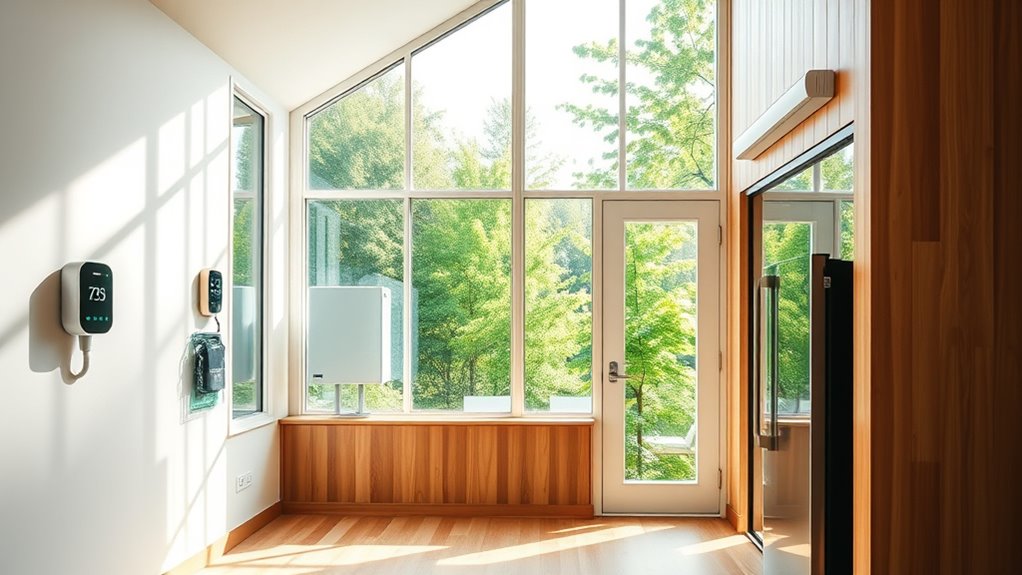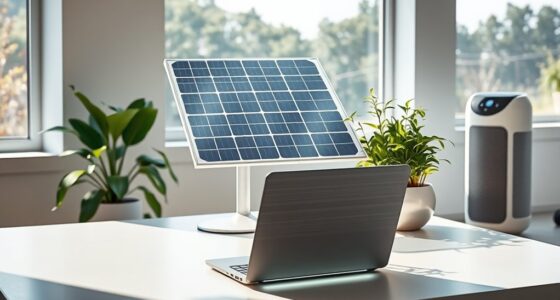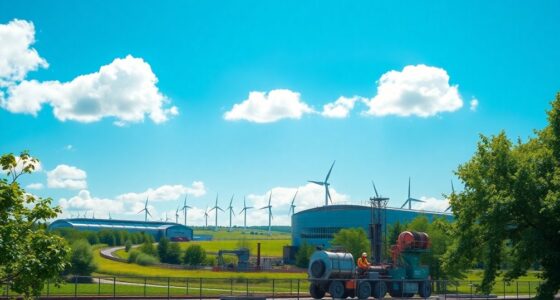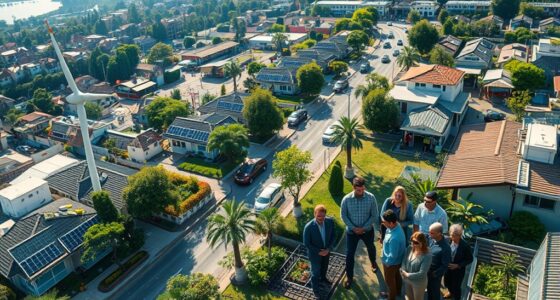Inside a net-zero home, smart technology helps you eliminate or drastically cut your energy bills. Solar panels generate renewable energy, while smart thermostats and automation optimize heating, cooling, and lighting based on real-time data and natural light. Appliances run during peak solar hours to maximize efficiency. Together, these systems create a self-sustaining environment that reduces reliance on traditional power sources. If you want to discover more about making your home truly energy-efficient, keep exploring how technology makes it possible.
Key Takeaways
- Solar panels generate renewable energy, reducing or eliminating reliance on traditional power grids and lowering energy bills.
- Smart thermostats optimize heating and cooling based on real-time data, enhancing energy efficiency and savings.
- Automated lighting and appliance systems adapt to natural light and peak solar hours for maximum energy utilization.
- Integrated smart home systems create a cohesive environment that minimizes unnecessary energy consumption.
- Using advanced technology promotes sustainable living while significantly reducing or eliminating monthly energy costs.

Inside a net-zero home, these technologies work in harmony. The solar panels provide the renewable energy needed for everyday activities, while smart thermostats optimize how that energy is used for heating and cooling. Together, they create a smart, efficient environment that reduces reliance on traditional power grids. You’ll notice that your energy bills decrease considerably, sometimes disappearing altogether, because the home produces as much energy as it consumes. It’s a seamless integration of renewable energy and intelligent automation, designed to make your life easier and more sustainable.
Furthermore, modern net-zero homes often incorporate other smart systems—like lighting that adjusts based on natural daylight or appliances that operate during peak solar hours—further enhancing energy efficiency. The goal is to create a living space that’s highly responsive and self-sustaining. When you step inside, you realize that technology isn’t just a convenience; it’s the foundation of a sustainable lifestyle. By embracing solar panels and smart thermostats, you’re not only reducing your environmental impact but also gaining independence from rising energy costs. It’s a glimpse into the future of home living—where innovation meets responsibility, and your home works tirelessly to eliminate your energy bill.
A new sentence with energy-efficient technology and the rest of the sentence.
Frequently Asked Questions
What Is the Initial Cost of Building a Net-Zero Home?
Building a net-zero home costs vary, but you should plan for a higher initial investment. You’ll incorporate renewable materials and smart appliances, which can increase upfront expenses but substantially reduce long-term energy costs. While the initial price might be higher than traditional homes, the savings on energy bills and environmental benefits make it worthwhile. Plus, incentives and rebates can help offset some of the upfront costs, making it more affordable.
How Long Does It Take to Recoup the Investment?
The payback period for a net-zero home’s investment timeline varies based on factors like energy costs and efficiency. Typically, you can expect to recoup your initial investment within 7 to 15 years. By installing solar panels, energy-efficient systems, and smart technology, you reduce ongoing expenses, speeding up the payback period. Over time, these upgrades can lead to significant savings, making your investment worthwhile and environmentally friendly.
Are Net-Zero Homes Suitable for All Climates?
You might wonder if net-zero homes suit your climate. They can work well in various conditions, but adaptations like solar shading help optimize energy efficiency. Good indoor air quality is also essential, especially in extreme climates. You’ll want to take into account local weather patterns and choose appropriate technology, ensuring your home remains comfortable and sustainable regardless of where you live. With the right design, net-zero homes are feasible everywhere.
What Maintenance Is Required for Energy Systems?
Sure, maintaining your energy systems isn’t exactly a joyride. You’ll need to keep up with solar panel maintenance—cleaning panels guarantees maximum efficiency—and regular HVAC upkeep to keep your home comfortable and energy bills low. Neglect these, and your high-tech systems might just throw a tantrum. But hey, a little effort now prevents costly repairs later, turning your home into a true energy-saving marvel.
How Do Net-Zero Homes Impact Property Value?
Net-zero homes can boost your property appreciation because they appeal to eco-conscious buyers and stand out in the market. As market demand for sustainable living grows, your home’s energy-efficient features and advanced technology can lead to higher resale value. You’ll likely see increased interest from potential buyers, making your property more desirable and potentially commanding a premium, ultimately benefiting your investment and supporting long-term market value growth.
Conclusion
Living in a net-zero home is like steering your ship through calm, sunlit waters—you’re in control, and the worries of rising energy costs drift away. With smart technology powering your sanctuary, you’re not just saving money; you’re creating a haven that breathes sustainability. This isn’t just about cutting bills; it’s about planting seeds for a greener tomorrow. So, embrace the future where your home is both a cozy refuge and a beacon of hope for the planet.









